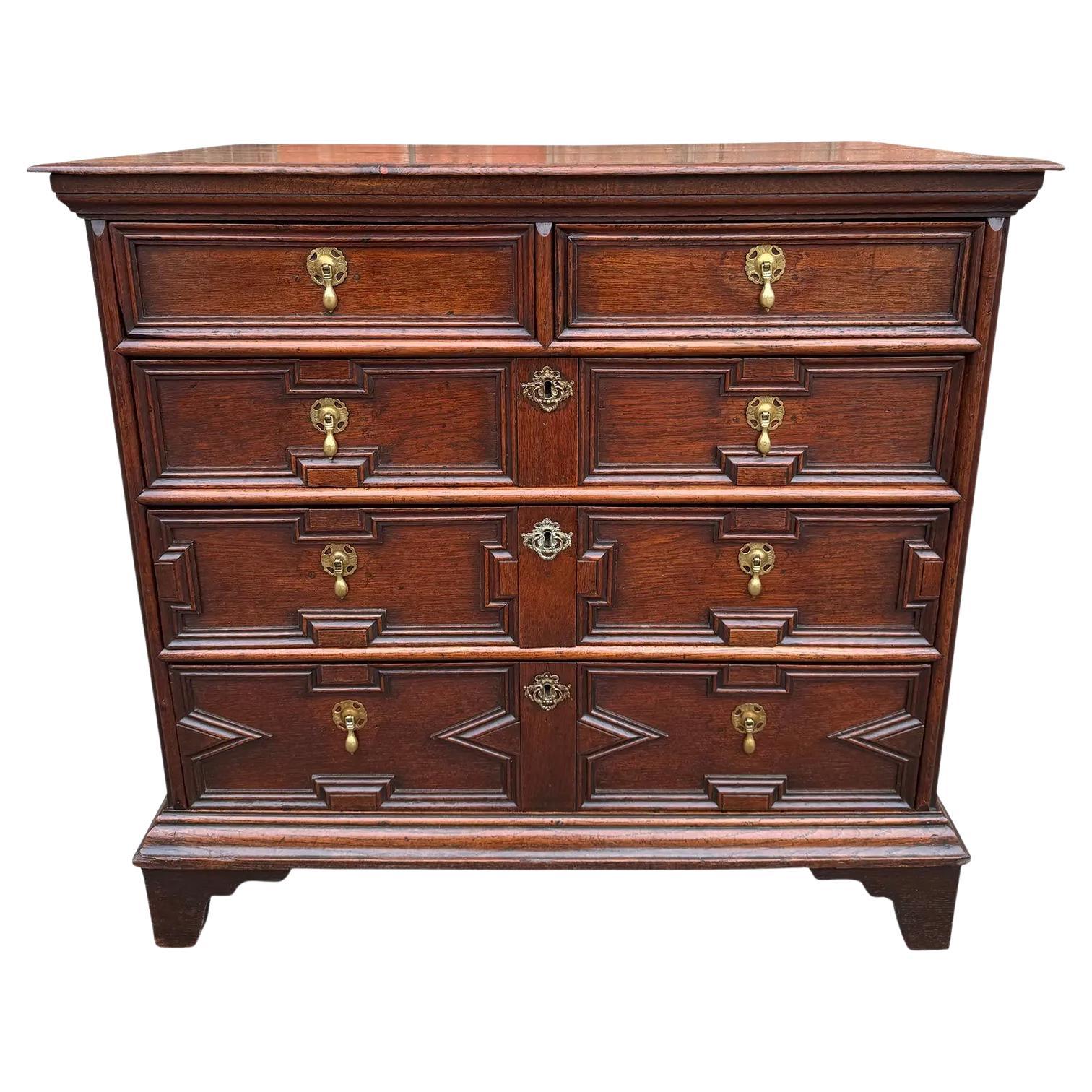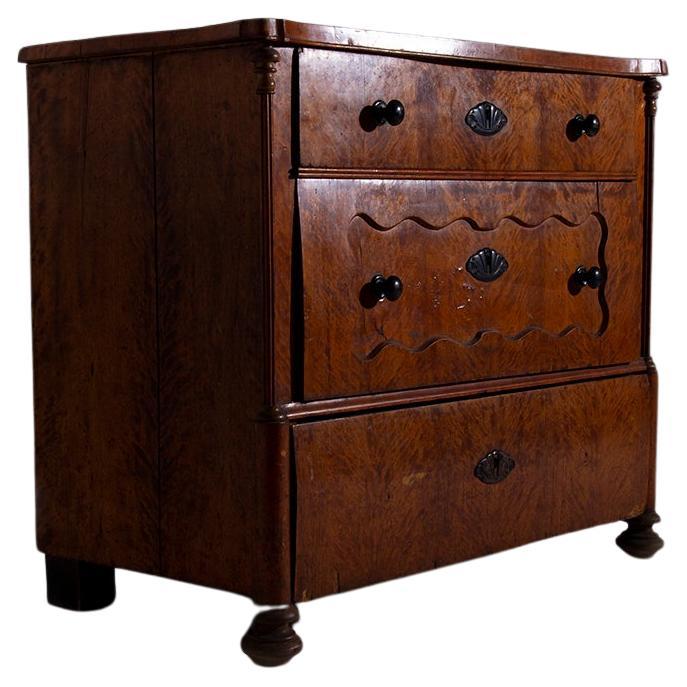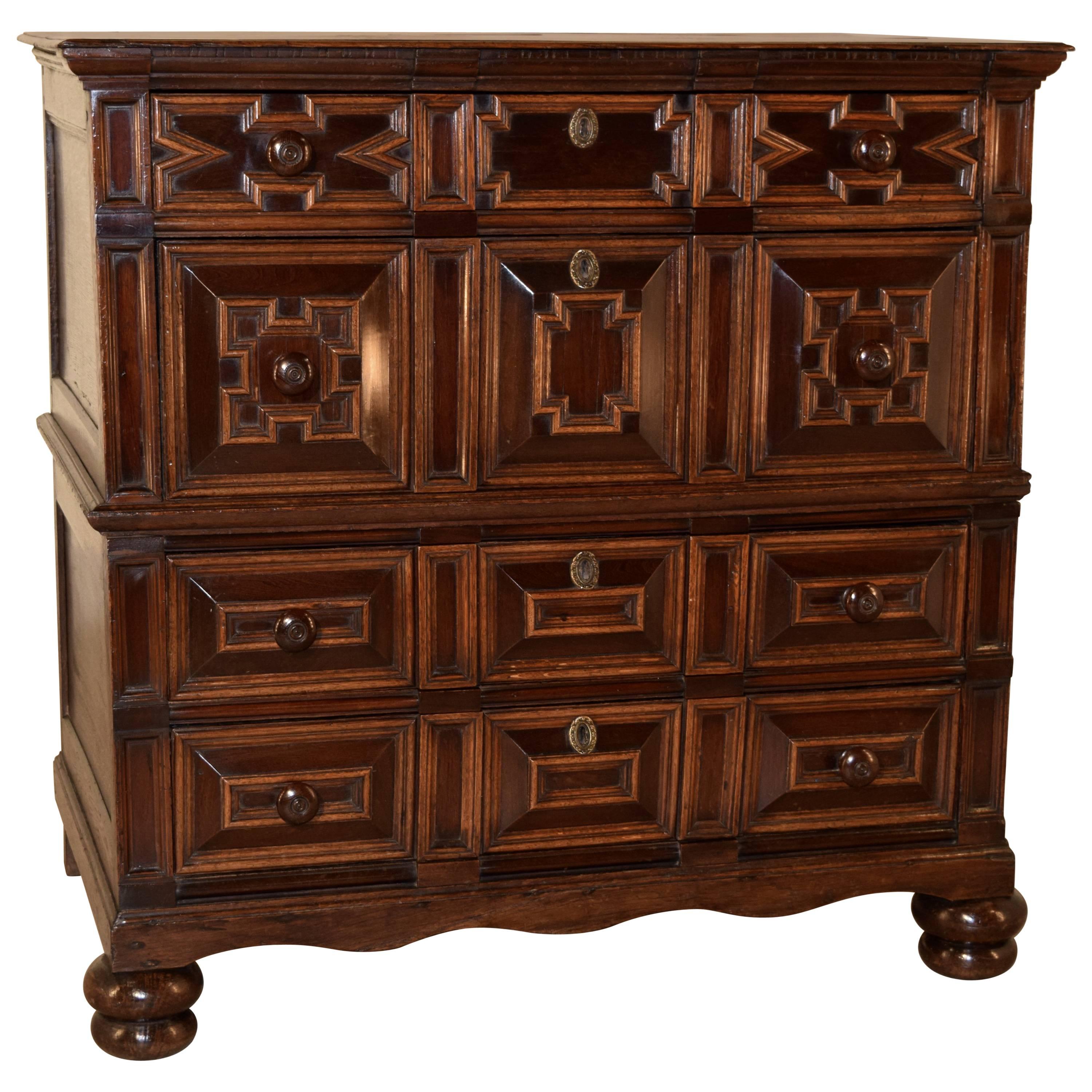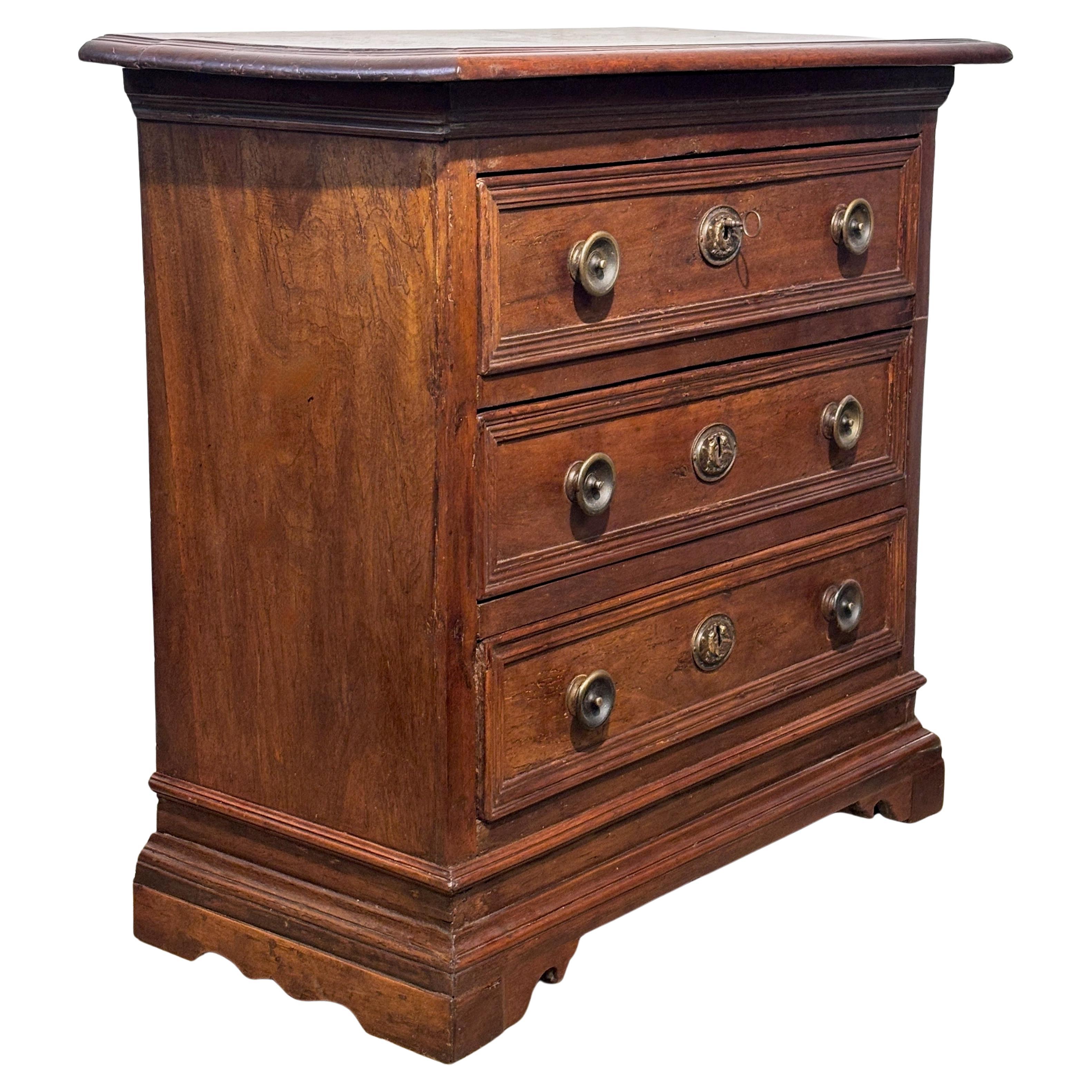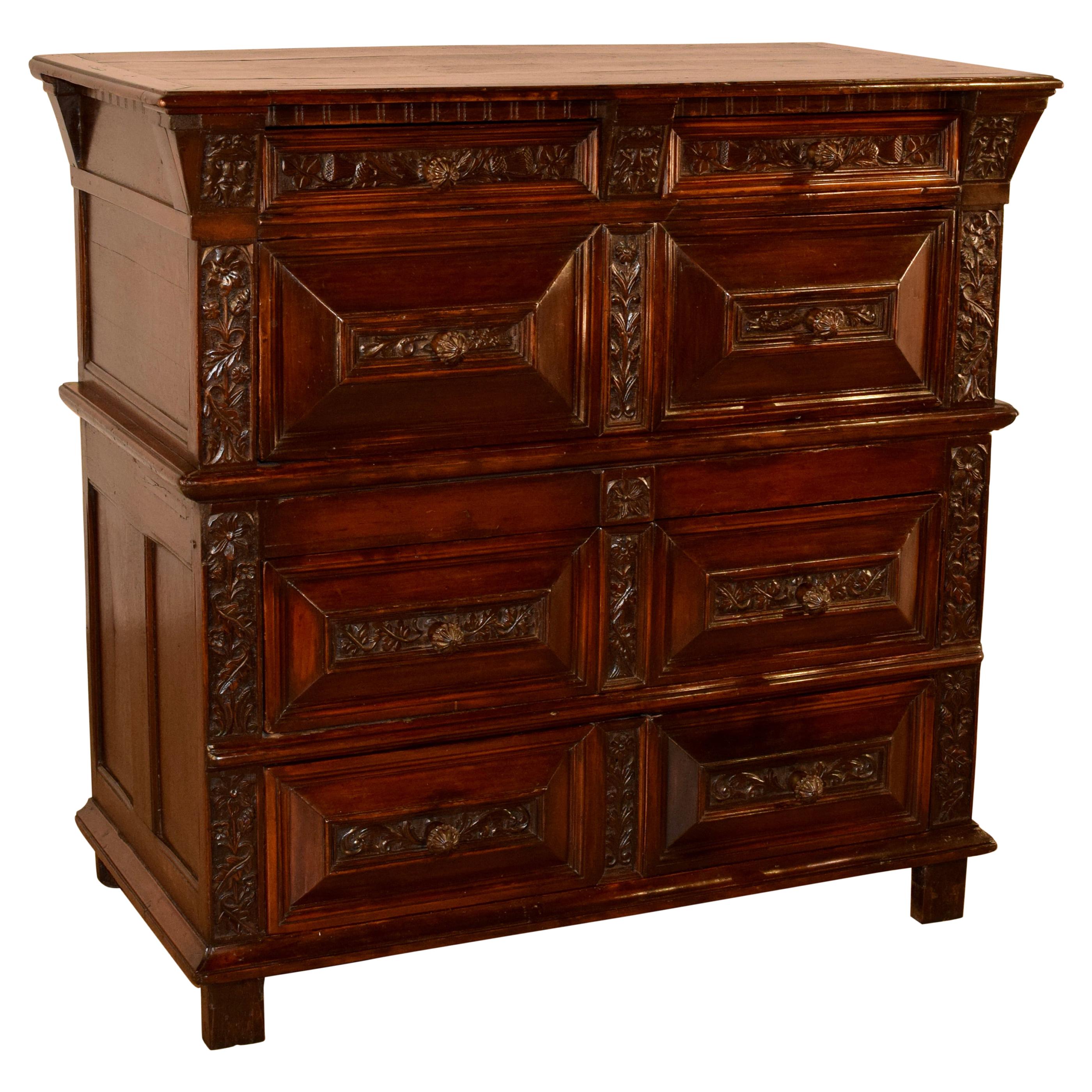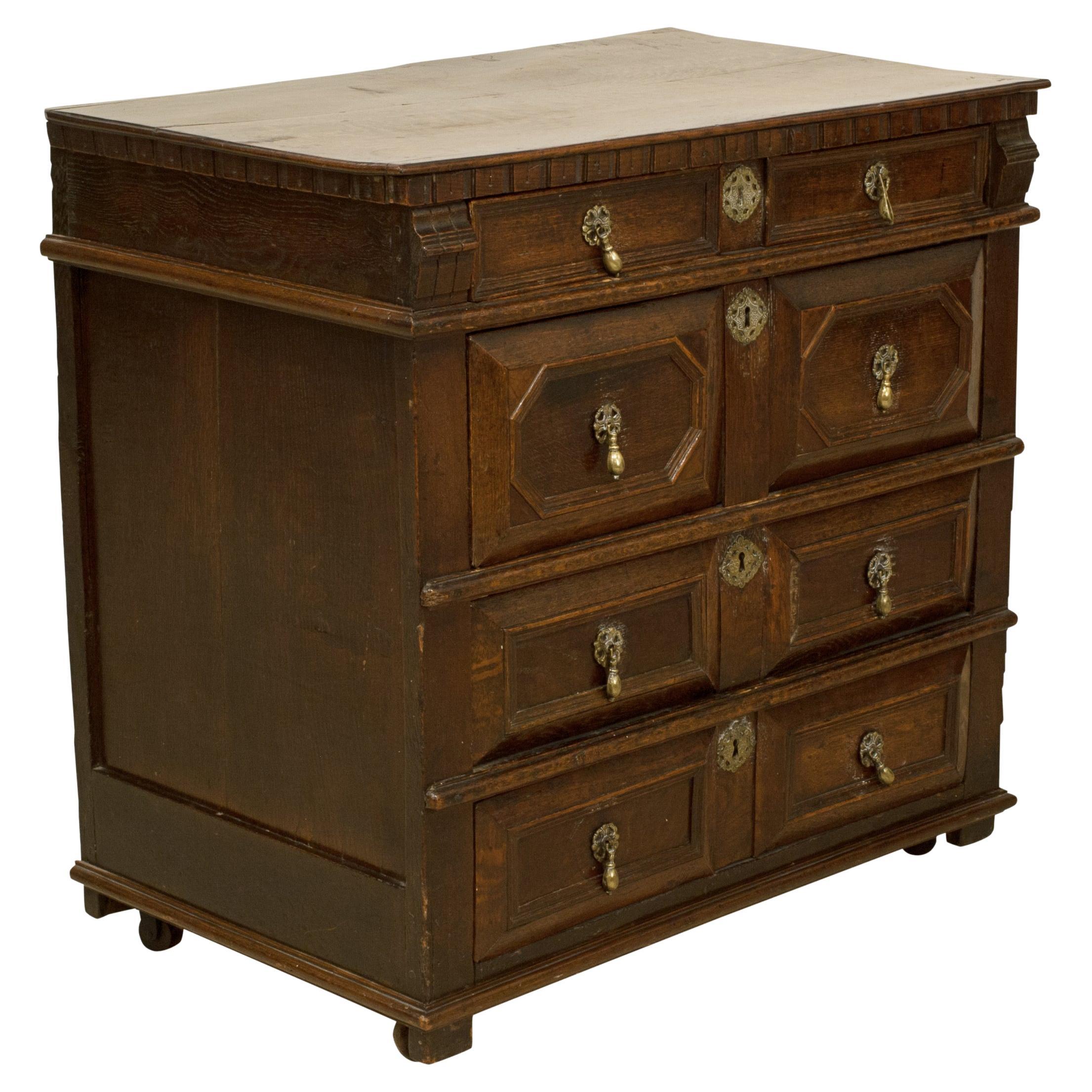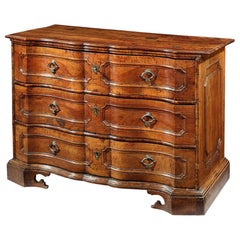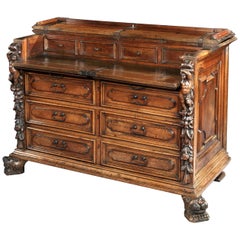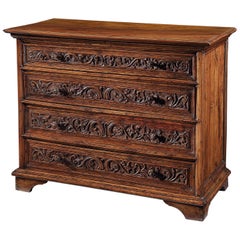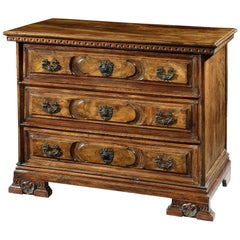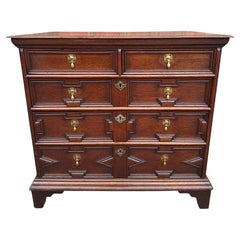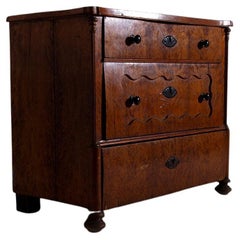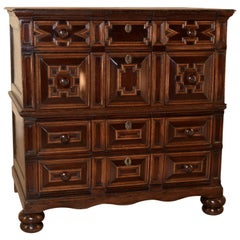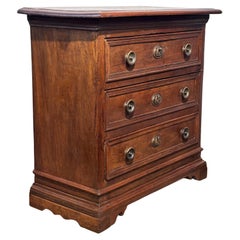Items Similar to Chest of Drawers Chest Commode Architectural Facade Enclosed Renaissance Cedar
Want more images or videos?
Request additional images or videos from the seller
1 of 17
Chest of Drawers Chest Commode Architectural Facade Enclosed Renaissance Cedar
$24,545.72
£18,000
€20,995.74
CA$33,911.92
A$36,977.31
CHF 19,623.49
MX$447,043.76
NOK 248,349.52
SEK 227,646.87
DKK 156,816.57
About the Item
A museum quality, English, Late-Renaissance, cedar enclosed chest of drawers with exceptional snakewood, walnut & oak with an architectural or façade front
This is the most sophisticated English model of chest of drawers conceived as a cabinet piece with an architectural front intended to disguise the drawers. This chest exhibits the mastery of English Late-Renaissance, cabinet making combining woods prized for their exoticism, color and beautiful figuring with carving and moulding in different ornamental patterns to simulate materials found within an architectural façade inviting conversation, curiosity and awe. The architectural vocabulary and the use of snakewod which was a highly fashionable exotic timber would be decoded by the cognoscenti as a high status, sophisticated piece which would have been made for a significant interior. Cedar was much prized for its rich color, light figuring and lustrous patina and it is rare to find large pieces in cedar which is why the top has been made from narrow sections. The success lies in the skill of the cabinet maker in balancing proportions, combining layers and different patterns of inlaid, carved and moulded woods of different colors with finely, figured graining to create a striking, statement piece which, when new, would have been very bright and the contrast between the woods would have been dramatic and dazzling. This chest is in exceptional condition, the replaced handles and feet is common as these elements have been subject to so much use over 400 years. It is robust and suitable for everyday use.
In two parts. The cedar top has six vertical sections, crossbanded with a moulded edge with a simulated dentil cornice below.
The upper section is fitted with a shallow, long, top drawer conforming to the frieze of a building with four pairs of double corbels dividing it into three vertical sections. The central section has a large, beautifully figured, snakewood panel surrounded by walnut moulding. The two similarly ornamented sections either side have central snakewood panels surrounded by multi-layered, cedar ‘H’ shaped mouldings with shallow rectangular walnut inlay above, below and snakewood on the sides to create the visual effect of depth.
The second, deep, long drawer in the upper section continues the architectural theme of an upper story of the facade with four cedar capitals and tapering pillars continuing the division into three vertical sections. The central section is headed by a rectangular, cedar section containing the original, chased brass escutcheon with deep cedar moulding aligning with the pillar capitals. Below is a central, walnut arch surrounded by a large, tiered arch, simulating stone, in cedar with snakewood ends and applied snakewood lozenges. The two similarly ornamented sections either side elaborate on the geometric mouldings in the drawer above. They have small central panels of cedar within which the brass handles are mounted, surrounded by a multi-layered, cedar moulding with walnut edge and oak inlaid corners to create depth, surrounded by large, snakewood panels, canted to show the figuring to maximum advantage, within multi-layered, cedar ‘H’ shaped mouldings with shallow snakewood inlay above, below and on the sides.
The lower section continues the architectural theme of the lower storey fitted with two doors, with a frieze of snakewood and walnut capitals above three cedar pillars. The doors with snakewood friezes faced by cedar moulding above massive, ‘H’ shaped moulded panels. Each with a finely, figured, central, cedar section surrounded by multi-layered cedar moulding with inlaid cedar corners and large, canted sections of snakewood within an ‘H’ shaped cedar moulding with snakewood panels above, below and to the sides. They both have skirtings of oak below with cedar inlay and the central pillar is sited on the inside edge of the right door, fitted with the original brass escutcheon. The doors opening to reveal three, fitted, oak drawers with their original, dry patina.
The brass handles are later replacements which is customary, the iron locks, hasp, working locks and two keys are original.
The sides continue the architectural form in a simpler language. The frieze has cedar corbels at either end with a cedar, top, dentil moulding and double ‘D’ lower moulding containing an oak panel with highly figured medullary rays and three geometric cedar panels. Both the upper and the lower sections contain a pair of oak, finely, figured moulded panels echoing those on the front.
Each section of the back has three oak panels.
The stile feet are later replacements which is common. The back feet have been spliced into the side and have characterful iron bands to reinforce the repair.
Provenance: Private collection.
Literature: Victor Chinnery 'Oak Furniture, The British Tradition' figure 3:406 illustrates a similar example.
- Dimensions:Height: 51.58 in (131 cm)Width: 47.05 in (119.5 cm)Depth: 24.81 in (63 cm)
- Style:Renaissance (Of the Period)
- Materials and Techniques:Cedar,Joinery
- Place of Origin:
- Period:Early 17th Century
- Date of Manufacture:circa 1620
- Condition:Wear consistent with age and use.
- Seller Location:BUNGAY, GB
- Reference Number:1stDibs: LU3867319398342
About the Seller
5.0
Vetted Professional Seller
Every seller passes strict standards for authenticity and reliability
Established in 1985
1stDibs seller since 2018
103 sales on 1stDibs
Typical response time: 5 hours
- ShippingRetrieving quote...Shipping from: BUNGAY, United Kingdom
- Return Policy
More From This Seller
View AllCommode, Early 18th Century, Italian, Venetian, Baroque, Walnut, Serpentine Front
Located in BUNGAY, SUFFOLK
The serpentine front on this magnificent commode is sophisticated and gives it gravitas. It has a rich colour and lustrous patina and has come from a private collection, Semenzato Ve...
Category
Antique Early 18th Century Italian Baroque Commodes and Chests of Drawers
Materials
Walnut
Cassettone Bureau-Chest Bambocci 16century Italian Renaissance Walnut Lombardy
Located in BUNGAY, SUFFOLK
AN EXCEPTIONAL MUSEUM QUALITY, ITALIAN, RENAISANCE WALNUT CASSETTONE WITH A FITTED BUREAU IN THE UPPER PART & EXCEPTIONAL BAMBOCCI CARVING, LOMBARDY
- This exceptionally rare, museum quality, piece of early furniture was conceived and crafted as an artwork of the finest quality of its time. Throughout time it has been a luxurious, statement piece which has protected it, and fortunately it has survived in virtually, original condition.
- This magnificent cassettone exudes the character and quality of the finest, late-Renaissance furniture.
Northern Italian Renaissance furniture often had the sides, legs or angles, 'a Bambocci', incorporating carved figures which were considered unique sculptures in their own right.
- The putti on this cassettone are beautifully carved and of sculptural quality. Each angel has one arm raised to heaven, a poignant touch.
- The lion’s paw feet are a classical feature and make a great statement.
- This cassettone was conceived to have visual impact through the quality of the carving, as well as being very practical with the writing compartment fitted in the top part.
- It has survived in very original condition with a few small repairs and losses, and the colour and patina are warm and lustrous.
- This cassettone is illustrated Illustrated in C. Alberici, Il Mobile Lombardo, Milan, 1969, p. 45, one of the seminal works on Lombardy furniture, and has been in two renowned collections.
The hinged top in two sections faced with a solid moulded edge. The front part has a fall front and opens to reveal a writing compartment. The fall front retains its original lock and is concealed with a false drawer which is above three drawers. All with moulded panels, escutcheons and retaining the original iron handles. The front ends have exceptional, bambocci, carved putti raising their arms to heaven above trailing foliage. Standing on magnificent lion's-head carved feet. The sides are panelled. Exceptional original colour and patina.
Literature : Illustrated in C. Alberici, Il Mobile Lombardo, Milan, 1969, p. 45. A Gonzalez-Palacois, Il mobile in Liguria, Genova, 1996 illustrates related pieces
Measures: Length 147 ½ cm. 58 in, height 104 cm. 41 in, depth 75 cm. 29½ in,
Provenance: Coll. Private Azzate The Collection of Sandro and Lidia Orsi, Ca’ Mera, Varese. Regarded as one of the most beautiful homes in Lombardy, Ca’ Mera, the country house of Sandro and Lidia Orsi was filled with beautiful objects from many different epochs. A renowned antiquarian from Milan, over his lifetime Sandro and his wife Lidia revived the Renaissance and Baroque character of the house and instilled their own unique vision into the interiors, which culminated with the creation of a Kunst – or Wunderkammer. “I have never seen such an example of poetical taste”, Sir John Pope...
Category
Antique 16th Century Italian Renaissance Commodes and Chests of Drawers
Materials
Walnut
Commode Cassetone Chest of Drawers Italian Brescia Lombardy Walnut Carved Front
Located in BUNGAY, SUFFOLK
This rare cassettone oozes charm and character. The carved decoration is particular to Brescia in Lombardy and the knobs are a rare feature carved as flowerheads to the petals behind...
Category
Antique Late 17th Century Italian Baroque Commodes and Chests of Drawers
Materials
Walnut
Commode, 18th Century, Italian, Venetian, Walnut, Small, Original Brassware
Located in BUNGAY, SUFFOLK
This Classic 18th century model is a rare, small size with a rich color and lustrous patina. From a private collection, Semenzato, Venezia.
Single plank top with solid moulded edge. The frieze with a band of gadrooned carving at the top. Below three drawers mouled with fine figuring original brass handles, escutcheon and locks only the top lock working. The pine drawers are lined with a block printed...
Category
Antique Early 18th Century Italian Baroque Commodes and Chests of Drawers
Materials
Walnut
Chest of Drawers Table Kneeler Inginocciatoio Walnut Venice Rule Carved Baroque
Located in BUNGAY, SUFFOLK
Venetian, baroque, small, walnut, Inginocchiatoio, table, chest or kneeler with a rule along the right lower end of the right side.
- In wonderful original condition with original...
Category
Antique 1680s Italian Baroque Commodes and Chests of Drawers
Materials
Walnut
Cassettone or Bureau-Chest, Late 16th Century, Italian Renaissance, Walnut
Located in BUNGAY, SUFFOLK
Exceptional museum quality, Italian, renaissance walnut cassettone with fitted bureau in the upper part & exceptional Bambocci carving, Lombardy.
This magnificent cassettone exudes the character and quality of the finest, late-Renaissance furniture. Late 16th century, Northern Italian furniture often had the sides, legs or angles, 'a Bambocci', incorporating carved figures which were unique sculptures in their own right. The putti on this cassettone are beautifully carved and of sculptural quality. Each angel has one arm raised to heaven, a poignant touch. Showing customary signs of wear from time, the lion’s paw feet make a great statement. This cassettone was conceived to have visual impact through the quality of the carving, as well as being very practical with the writing compartment fitted in the top part. It has survived in very original condition with a few small repairs and losses, and the color and patina are warm and lustrous. This cassettone was illustrated in one of the seminal works on Lombardy furniture in the 1969 and has been in two renowned collections.
The hinged top in two sections faced with a solid moulded edge. The front part has a fall front and opens to reveal a writing compartment. The fall front retains its original lock and is concealed with a false drawer which is above three drawers. All with moulded panels, escutcheons and retaining the original iron handles. The front ends have exceptional, bambocci, carved putti raising their arms to heaven above trailing foliage. Standing on magnificent lion...
Category
Antique 16th Century Italian Baroque Furniture
Materials
Walnut
You May Also Like
19th Century English Jacobean Chest of Drawers
Located in Nashville, TN
This is a beautiful circa 1860 English Jacobean of chest drawers. As traditional with the Jacobean style these chest are always very unique typically of a geometric form. This chest ...
Category
Antique 1850s English Commodes and Chests of Drawers
Materials
Hardwood
Italian Sicilian wood briar Italian chest of drawers late 1800s
Located in Milano, IT
Allow me to transport you to the exquisite world of antique Sicilian craftsmanship with a late 1800s dresser that encapsulates the essence of Italian ar...
Category
Antique 1890s Italian Neoclassical Commodes and Chests of Drawers
Materials
Wood
$3,338 Sale Price
20% Off
17th Century Geometric Chest of Drawers
Located in High Point, NC
17th century unusual two-piece chest of drawers. The top is made up of oak planks, and has a beveled edge. There is old restoration, staining and discoloration on the top from honest...
Category
Antique 17th Century English Charles II Commodes and Chests of Drawers
Materials
Oak, Rosewood
17th Century Italian Walnut Chest of Drawers
Located in San Francisco, CA
A 17th Century (possibly older at late 16th century) Italian walnut chest. This rare antique features three drawers, all with original period locks and hardware that speaks to its ri...
Category
Antique 17th Century Italian Renaissance Commodes and Chests of Drawers
Materials
Walnut
17th Century Carved Two Piece Chest of Drawers
Located in High Point, NC
17th century carved two piece chest of drawers from Scotland made from walnut and rosewood. The top is banded and has a beveled edge surrounding a four board top. The sides are hand ...
Category
Antique 17th Century Scottish Charles II Commodes and Chests of Drawers
Materials
Rosewood, Walnut
Antique Oak Chest Of Drawers
Located in Oxfordshire, GB
Jacobean Style Chest Of Drawers.
A handsome and nicely proportioned Jacobean style antique oak chest of drawers raised on four castors. The graduatin...
Category
Antique Early 19th Century British Jacobean Commodes and Chests of Drawers
Materials
Oak
More Ways To Browse
Pair Of Antique Chest Of Drawers
Light Wood Chest Of Drawers
Chest Of Drawers Inlaid Wood
Pairs Of Three Drawers Chests
Walnut Pair Of Chests Of Drawers
Chest Of Drawers Oak Used
Cedar Antique Furniture
Very Large Antique Chest Of Drawers
Walnut And Oak Chest Of Drawers
Antique European Chest
English Oak Chest Of Drawers
English Oak Chest On Chest
Used Cedar Chests
English Walnut Chest Of Drawers
Cedar Chests
English Antique Walnut Chest Of Drawers
Chest Of Drawers Stone Top
Antique Cedar Chest
